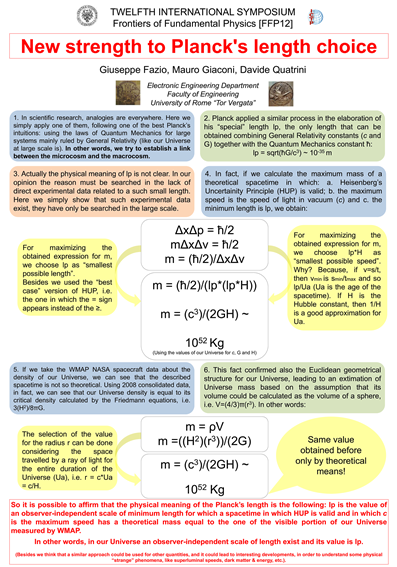Giuseppe Fazio is since 1987 Professor of Electrical Measurements at the Università degli studi di Roma – Tor Vergata.
In the field of railway signaling, as reported by several newspapers, is considered a leading expert and has also held public functions in this sector: in 2009 was named as one of seven members of the TAB (Technical Advisory Board) INESS project (Integrated European Signaling System) of the Seventh European framework and he was in the register of experts ANSF (Agenzia Nazionale Sicurezza Ferroviaria), etc. ..
He has several publications, patents on various topics among which: systems microprocessor, data acquisition, transmission and processing of data in environment with high degree of electromagnetic noise, recognition systems for diagnostic of complex systems, both statistical and deterministic, based on analysis of state parameters associated with vibrational waves emitted by them, analysis of biological effects of non-ionizing radiation.
His research work was often aimed at the development of innovative applications in collaboration with leading companies in different industries (e.g. ACEA Network Italian railway, MAEL, Fatme, ENEL, ISPESL, SIRTI, Ansaldo, CONTRAVES, ITALCERTIFER, ROME RESEARCH, Etc..)
Lately, he is also interested in theoretical physics by presenting a model for the universe that could help to create a bridge between quantum mechanics and relativity, explaining mysterious phenomena such as the so-called dark matter, in this sector he has already published four articles well.

CONGRESSO Mondragone 30-5-2007 : Da sinistra: ing M. Serra (Preside CIFI – Roma), Prof G. Fazio (Misure Elettriche Università di Roma “Tor Vergata”),ing M.M. Elia (Amministratore Delegato RFI SpA), Prof A. Finazzi Agrò (Rettore Università di Roma “Tor Vergata”), Prof A. La Bella (Preside Facoltà Ingegneria “Tor Vergata”), Prof F. Giannini (Direttore Dipartimento Ingegneria Elettronica “Tor Vergata”),ing E. Marzilli (Dirigente RFI SpA – Direzione Tecnica)

CONGRESSO Tor VERGATA 8-9-2009 : Da sinistra: On. C. Ventucci (Vicepresidente commissione finanze), Prof. V. Rocco (Preside Facoltà Ingegneria “Tor Vergata”), Prof G. Fazio (Misure Elettriche Università di Roma “Tor Vergata”),ing M.M. Elia (Amministratore Delegato RFI SpA), Prof A. Finazzi Agrò (Rettore Università di Roma “Tor Vergata”), ing M. Serra (Preside CIFI – Roma), Prof. C. Corsi (Consiglio di ammiistrazione Roma Ricerche) , Prof F. Giannini (Direttore Dipartimento Ingegneria Elettronica “Tor Vergata”),Prof. G. Betta (Segretario GMEE), Prof. B. Sciutto (Presidente NITEL)
*************************************************************************************************************
OFFERTE DI COLLABORAZIONE/STAGE STUDENTI : MICROELETTRICA SCIENTIFICA
*************************************************************************************************************
Pubblicato sulla rivista “Global Railway Review. Issiue 04 2017,ISSN 251”
“New horizons for train location and signaling: a brief description of technical solutions to well-known criticalities of track circuits“
di: G.Fazio, M.Giaconi, S.Vetruccio, M.Telesca, A.Giuliani
ABSTRACT
In spite of great advancements in Railway signalling system, some concerns still exist, notably about SIL 4 (Safety Integrity Level) train locationing. In the following, the issues related to present used systems are depicted together with some proposals in order to overcome those problems, currently under study in academic world.
**************************************************************************************************************************************************************
Pubblicato sulla rivista “Journal of Physical Science and Application ISSN 2159-5348, USA”4(8)(August 2014)
“Bits, Mass and Acceleration Issued in BSC”
DOI: 10.17265/2159-5348/2014.08.09,
di:G. Fazio, M. Giaconi, D. Quatrini
ABSTRACT
Abstract: The goal of the present paper is to expand already published works in the frame of “Banded speed cosmology” (BSC). In particular this paper gives validated values for physical quantities not so far investigated in previous publications, i.e., the number of individual physical entity in the universe, as well as the maximum value for acceleration. Validates values mean identical quantities from a numerical point of view obtained with different theoretical procedures, additionally compared with data based on NASA observations with Planck probe.

***********************************************
***************************************************************************************************************
